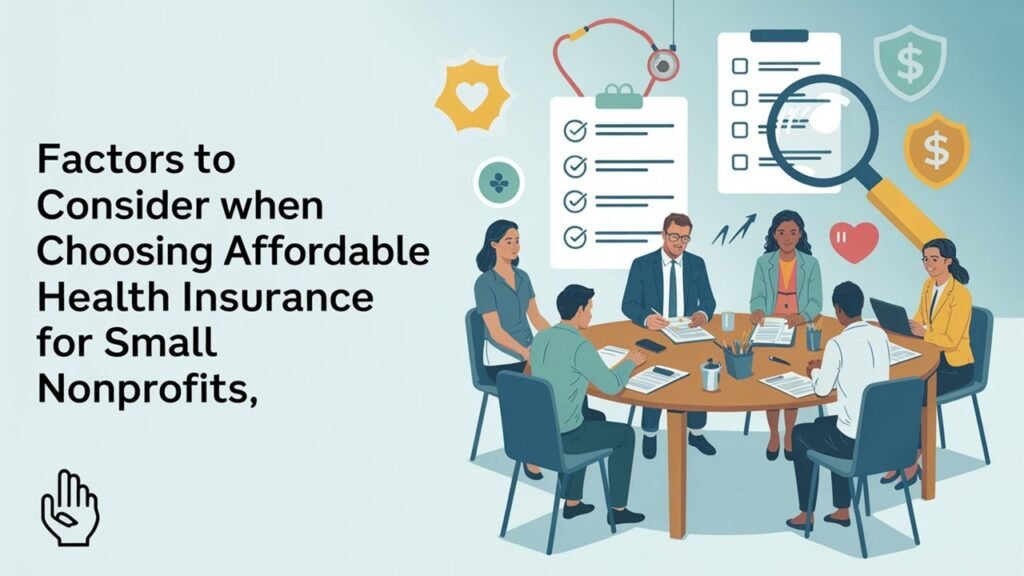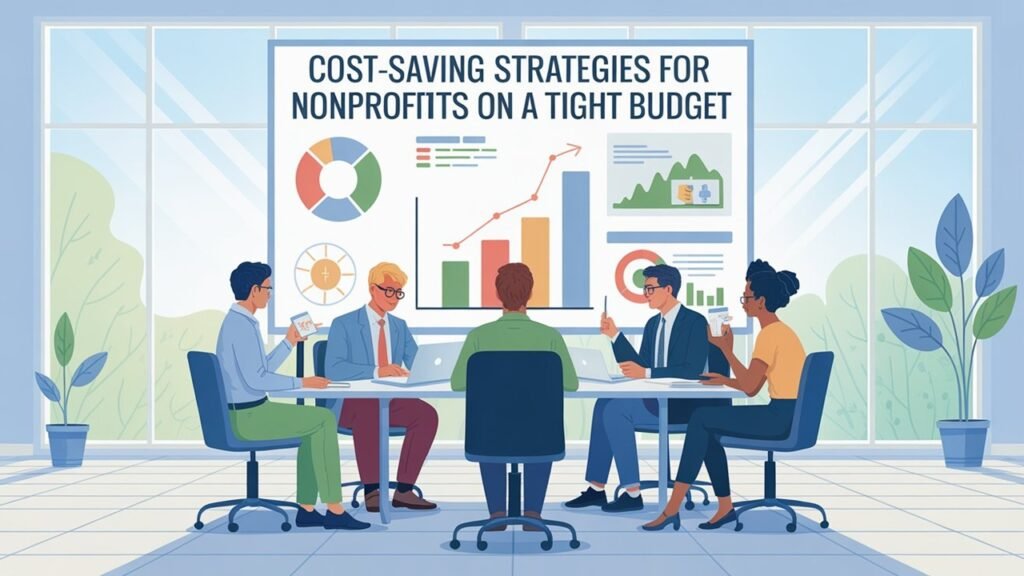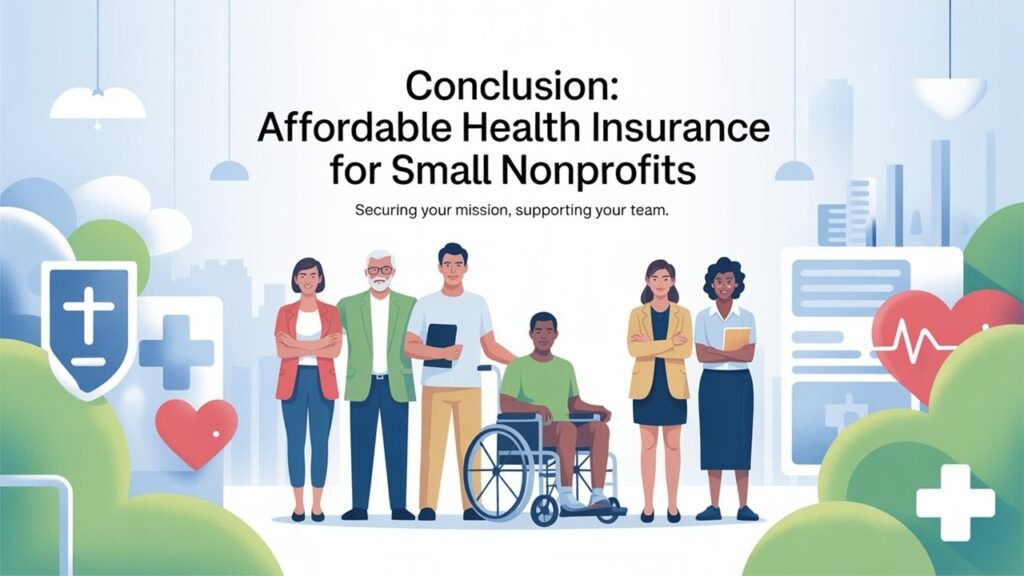Introduction: Health Insurance for Small Nonprofits
It has never been more challenging for small nonprofits to obtain reasonably priced health insurance. The cost of healthcare in the US is still increasing more quickly in 2025 than many nonprofits can keep up with. However, if you want to draw and keep top talent in the nonprofit sector, providing high-quality health coverage is now a must.
Health insurance is a strategic investment in your mission, not just an employee benefit for small nonprofits. A well-supported and healthy workforce is more devoted, more productive, and better able to serve your community. Finding a balance between affordability and high-quality coverage is the problematic part.
Why is it so critical Health Insurance for small nonprofits?
- Hiring and keeping good employees: People with skills often look at benefits packages before accepting a job. You could lose candidates to other organizations that do offer health insurance if your nonprofit doesn’t.
- Employee Well-Being: Employees are less likely to get burned out or miss work when they have access to preventive care, mental health services, and cheap prescriptions.
- Legal and Compliance Factors: Depending on how many people you have on staff, the Affordable Care Act (ACA) may require you to offer insurance or pay fines.
The Health Insurance for Small Nonprofits Reality of 2025
Many nonprofits will have to contend with a “benefit gap” in 2025 as they bid against larger, private-sector companies for qualified workers. Nonetheless, new low-cost health insurance options have surfaced, such as
- State-funded nonprofit initiatives.
- Group health insurance cooperatives.
- High-deductible health plans combined with HSAs.
- Telehealth and virtual care supplements.
Without going over budget, these choices can assist small nonprofits in providing value to their staff.
What This Guide Will Teach You
This all-inclusive resource will guide you through:
- In the market for health insurance, what constitutes a small nonprofit?
- Things to take into account when contrasting nonprofit health plans
- The most cost-effective health insurance companies for nonprofits in 2025
- Cost-cutting techniques that small businesses can truly implement
- Nonprofit case studies that demonstrate the effective implementation of affordable coverage
By the end, you will have a well-defined and feasible strategy to provide your nonprofit employees with affordable, competitive, and compliant health insurance.
Understanding Health Insurance for Small Nonprofits:
It’s critical to comprehend how health insurance functions in the nonprofit sector before delving into quotes, providers, and cost-cutting measures. Understanding the fundamentals will enable you to make more informed, cost-effective decisions because small nonprofits encounter different opportunities and challenges than larger organizations.
What Counts as a ‘Small Nonprofit’ in the Health Insurance Market?
Small nonprofits are typically defined as those with fewer than 50 full-time equivalent employees (FTEs) for health insurance. This classification is significant for the following reasons:
- Specific state-level programs and tax credits are exclusively available to nonprofits in this size range.
- Organizations with fewer than 50 FTEs are not legally required to provide health insurance under the Affordable Care Act (ACA), but doing so can still give them a competitive edge.
- Smaller nonprofits may be eligible for co-op coverage or association health plans that are unavailable to larger organizations.
Tip: Only full-time equivalents count toward the ACA threshold, even if you have volunteers or part-time staff.
Common Misconceptions About Nonprofit Health Plans
Most small nonprofit leaders believe that offering health coverage is out of their reach. Some of these include:
Big Nonprofit Myth #1: Big nonprofit health insurance is the only way to offer a plan.
→ The Reality: Many nonprofits under 20 are still competitive, sometimes with group plans, subsidized premium payments by the employee, or through a co-op.
Fact #2: “Group plans are never the cheapest for employees.
→In reality, group coverages can provide greater benefits at a lower per-person cost than what the individual employee may be able to buy on her own.
Fable 3: “Health Benefits Are a Luxury”
Reality: Health insurance is now a central facet of compensation; without it, you are at a severe disadvantage compared to other employers in today’s hiring market.
Key Terms You Should Know Before Comparing Plans
The terminology used in health insurance can sound like a foreign language! Below are some of the necessary terms to remember.
- Premium: The monthly cost you pay for the plan.
- Deductible: The amount that an employee has to absorb for insurance in the event of a claim.
- Co-pay: A set fee for a particular service (e.g., $25 per doctor visit).
- Co-insurance: The percentage of costs the employees must pay once their deductible is met.
- Network: The doctors, hospitals, and other providers within the plan.
💡 Pro tip: Lower premium plans typically have higher deductibles. It is critical to understand the trade-off when purchasing more cost-effective nonprofit health insurance options.

Factors to Consider When Choosing Affordable Health Insurance for Small Nonprofits
Finding the best health insurance for small nonprofits is just the first step; a buyer must also consider other factors. The right decision finds the equilibrium between cost, coverage, compliance, and employee satisfaction — in a way that serves your nonprofit’s mission and budget.
Coverage vs. Cost: How Do You Find the Right Balance?
For small nonprofits, it is one of the more significant decisions regarding how much to insure and not overextend.
- With lower premiums, you often have higher deductibles, which can be costly for employees.
- This may be expensive for comprehensive coverage, but it can help you keep staff turnover and absenteeism low.
- Consider the compensation package: typically, more job security and better benefits come with a slightly lower salary offer.
💡 Pro Tip: Survey employees anonymously to better understand their healthcare needs and inform plan selection.
Plan Types: HMO, PPO, EPO, or POS: Which Fits a Nonprofit Best?
Different plan types differ subtly in cost and flexibility trade-offs:
- HMO (Health Maintenance Organization): Lower cost, limited flexibility, must choose a primary care doctor whom you can only see with a referral.
- PPO (Preferred Provider Organization): PPOs are generally more flexible than HMOs; they will cover appointments with specialists directly, without a referral.
- EPO (Exclusive Provider Organization): There is no out-of-network coverage, but premiums are frequently less expensive than a PPO on a per-paycheck basis.
- POS (Point of Service): A mix of the HMO and PPO plans where services are authorized through a primary care physician, but out-of-network coverage is available.
Nonprofits: HMOs and EPOs may make more financial sense for a small team, while PPO plans could be what your staff prefers if they need broader provider access.
ACA Compliance and Legal Requirements for Nonprofits
The ACA requires you to provide health insurance coverage if your nonprofit employs 50 or more full-time equivalent workers.
- Offer minimum essential coverage.
- Make coverage affordable (9.12% of household income for the employee)
- Meet minimum value standards.
The good news is that you can avoid severe penalties related to noncompliance with the IRS regulations. Not only will this make your nonprofit more competitive for recruiting top staff, but others in the sector are likely to work at or above ACA benefits levels.
Additional Benefits That Boost Employee Satisfaction
Core benefits of health insurance plus affordable extras that can have a significant impact on morale, e.g.
- Low-cost add-ons with a high perceived value: Dental and vision coverage
- Behavioural health: teletherapy or counselling privileges, etc.
- Telehealth: A convenient, cost-effective access for both the employer and employee.
- Gym discounts, preventive screenings, and health coaching with wellness programs.
These are often small add-ons that can help your nonprofit stand out from comparably budgeted organizations.
Best Affordable Health Insurance Options for Small Nonprofits in 2025
In 2025, the best affordable health insurance for small nonprofits involves comparing various carriers and plans, as well as understanding how to purchase coverage. Your budget, team size, location, and coverage requirements dictate the best choice. Here are the best choices you can make this year.
Top Group Health Insurance Providers for Nonprofits
Secure Top Insurance Companies for Small Business or Nonprofit. Many of the major insurance companies offer specialized plans aimed at small businesses or nonprofits that have a good balance between reasonable premium payments and decent benefits.
Popular nationwide options include:
- UnitedHealthcare: Large network of providers, best group rates for nonprofits.
- Blue Cross Blue Shield: Low-cost, nonprofit-friendly plans in most states; excellent mental health coverage.
- Aetna: Flexible plan designs with wellness and telehealth options.
- Cigna: Robust preventive care benefits, coverage available nationwide.
💡 TIP: Be sure to ask for nonprofit rate sheets. Some carriers offer the same or even lower pricing, but at a discount to 501(c)(3) organisations.
State and Local Health Insurance Programs
A few states either run their group health programs or offer subsidies for nonprofits.
- See if your state’s SHOP marketplace provides access to nonprofit coverage.
- Some states (e.g., California, New York, and Massachusetts) provide premium assistance programs to eligible employers.
📍 Check in with your state Department of Insurance to see whether there are nonprofit programs available in your region.
Health Insurance Purchasing Alliances and Co-ops
Small nonprofits can pool their buying power with other organizations by joining a purchasing alliance or cooperative.
- In many cases, Nonprofit Insurance Alliance and statewide nonprofit associations offer preferred provider arrangements.
- Leveraging this model allows co-ops to negotiate lower premiums, better benefits, and reduced admin costs.
This won’t be of much benefit if you are a company with over 25 employees or can negotiate better rates independently.
Association Health Plans (AHPs) for Nonprofits
Specific nonprofit associations and chambers of commerce members may also provide group health plans to their members.
- This includes local non-profit ecosystems, professional organizations, and mission-driven co-ops.
- May have industry-specific benefits (eg, performance injury coverage for arts nonprofits)
The membership fees are typically small compared to the significant savings you’ll get on your insurance.

Cost-Saving Strategies for Nonprofits on a Tight Budget
Even the best affordable health insurance for small nonprofits can be expensive for this minimal budget. The good news? But some battle-tested tricks can save you money without compromising on comprehensive coverage.
Leveraging Tax Credits and Subsidies
If your nonprofit has fewer than 25 full-time equivalent employees and pays average wages less than $63,000 (2025 threshold), you could be eligible for a small business health care tax credit.
- How much you can save: Up to 50% of your premium contribution in the form of a tax credit.
- Eligibility: SHOP Marketplace coverage available to you; must pay at least 50% of premiums for employee-only coverage.
🔵 Next step: File IRS Form 8941 to be able to claim 💸
Choosing High-Deductible Plans with HSAs
A High-Deductible Health Plan (HDHP) coupled with a Health Savings Account (HSA) can be a win-win:
- Lower Monthly Premiums for the Nonprofit.
- HSA also falls under 401(k); employees can contribute pre-tax dollars in their HSA, which is only used for medical expenses.
- HSAs roll over year to year, leading to long-term value for employees.
TIP: To make the plan more attractive, perhaps consider an employer HSA contribution.
Negotiating Group Rates
The initial quote is never the best you will find.
- Ask for estimates from at least three companies.
- Note that if you are in a non-profit network or association, some carriers provide discounts.
- Request tailored plan designs that align with your staff utilization.
📌 Pro tip: Just a 5% rate reduction can easily save $thousands per month for a smaller non-profit.
Encouraging Preventive Care to Reduce Long-Term Costs
Ultimately, implementing preventive care interventions is an investment in consequence management that will result in lower claims and premiums in the long run.
- Provide wellness rewards for yearly check-ups and health screenings.
- Telehealth services are essential to help avoid ER visits.
- Provide mental health guidance to help prevent burnout-related absenteeism.
How to Get Started With Health Insurance for Nonprofits
A roadmap for affordable health insurance for small nonprofits. Reducing health insurance costs is a priority for many small nonprofits. Whether you are in the market to offer a new plan or just renewing an existing plan, following a structured process helps ensure that you make an informed, cost-effective decision that will help keep employees happy about benefits.
Step-by-Step Plan to Secure Affordable Nonprofit Health Coverage
- Assess Employee Needs
- Check out benefits like low deductibles, mental health services (you can get meds mailed to you these days), and vision/dental.
- Usage Patterns— This enables a yardstick to avoid overpaying for underutilized coverage.
- Research Available Options
- Evaluate group health plans, co-op memberships & association plans.
- If you qualify for nonprofit status with national carriers, check with state programs during open enrollment.
- Get Multiple Quotes
- You should also be able to reach out to at least 3 different providers for quotes.
- Inquire about nonprofit discounts, or they may have different rate structures.
- Check ACA and State Compliance
- If you have 50+ FTEs, make sure your plan is Affordable Care Act compliant.
- Be mindful of the state-specific regulations, especially if you do business in multiple locations.
- Communicate Clearly With Staff
- Share plan details in simple language.
- Show combined charts to help employees recognize how different the options are from each other.
- Review Annually
- Re-Enrol in the Marketplace Annually: Rates and provider networks change annually.
- Conduct annual employee surveys to ensure the plan remains relevant and up-to-date.
Common Mistakes to Avoid When Choosing Nonprofit Health Insurance:
- Last-Minute Decisions that could have been avoided — hasty decisions can result in more expensive and inferior coverage.
- Not factoring in the employees, what is theoretically a great plan may not fit with real needs.
- Often, a slightly higher premium equals lower out-of-pocket expenses, which makes more sense to employees over the long haul.
- Conclusion wraps things up, highlighting the importance of understanding co-ops and associations. Thousands of dollars are lost every year when individuals miss out on group discounts.

Conclusion: Affordable Health Insurance for Small Nonprofits
Affordable health insurance for small nonprofits is not only a real possibility, but also something you can achieve with the right strategy. Balancing cost, compliance, and care quality needs to be a strategic process, partnering with your broker who analyses what your team needs (and when) from plan structure, nonprofit discounts, and strategic plan choices year after year.
The solution, of course, is to think about health coverage as an investment in your people and not just another line on the income statement. Your retention, productivity, and mission impact will increase as employees are well-supported with quality benefits.
We will have more tools, partnerships, and funding opportunities than ever before to enable nonprofits to provide fantastic coverage at sustainable costs in 2025. Get the basics right, stay up-to-date, and adapt as your company evolves. Your team AND your mission will thank you.
Check out the Daily usage tools. Click the button below
FAQs – Affordable Health Insurance for Small Nonprofits [2025]
1. What is the best health insurance option for small nonprofits?
That depends on your budget/Team size, which also needs to grow. Most smaller nonprofits will find that SHOP plans, association health plans, or healthcare co-ops are more affordable options. Always compare multiple quotes.
2. How much does health insurance cost for a small nonprofit?
Standard group health insurance will cost $400 to $800 per employee per month on average for small nonprofits by 2025, depending on the type of coverage, region, and network.
3. Can small nonprofits get health insurance discounts?
Yes. Several insurers offer discounts specifically for nonprofits or group rates. You might also consider joining an association or healthcare cooperative, as many people have saved a significant amount through them.
4. Do nonprofits have to offer health insurance under the ACA?
Your nonprofit must provide coverage that meets minimum standards if you have 50 or more full-time equivalent employees, in part to meet the requirements of the Affordable Care Act. While there is no legal obligation for smaller nonprofits to offer coverage, they often choose to attract and retain talent.
5. What’s the difference between group health plans and individual coverage for nonprofits?
Individuals working for your group can be set up on a group health plan by the employer as an incentive to retain workers. The employee buys their coverage. Group plans usually cost less per person and offer far more consistent benefits.
6. Are there grants to help small nonprofits afford health insurance?
Yes. Funding from various state programs, local foundations, and private grants is available to support employee benefits. There are also state departments of insurance and non-profits that provide help.




